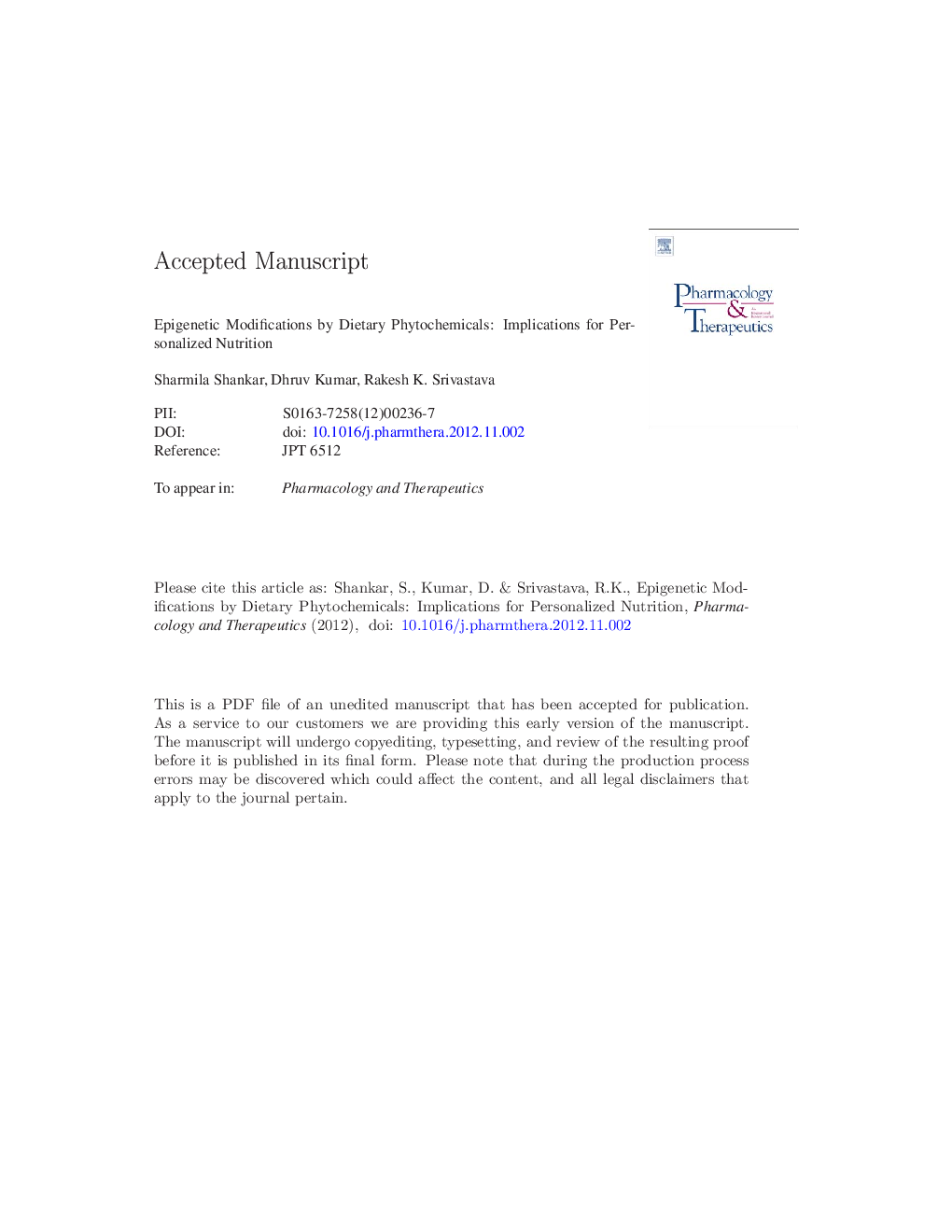| Article ID | Journal | Published Year | Pages | File Type |
|---|---|---|---|---|
| 5844034 | Pharmacology & Therapeutics | 2013 | 46 Pages |
Abstract
In the last two decades, the study of epigenetic modification emerged as one of the major areas of cancer treatment targeted by dietary phytochemicals. Recent studies with various types of cancers revealed that the epigenetic modifications are associated with the food source corresponds to dietary phytochemicals. The dietary phytochemicals have been used in Asian countries for thousands of years to cure several diseases including cancer. They have been reported to modulate the several biological processes including histone modification, DNA methylation and non-coding microRNA expression. These events play a vital role in carcinogenesis. Various studies suggest that a number of dietary compounds present in vegetables, spices and other herbal products have epigenetic targets in cancer cells. Dietary phytochemicals have been reported to repair DNA damage by enhancing histone acetylation that helps to restrain cell death, and also alter DNA methylation. These phytochemicals are able to modulate epigenetic modifications and their targets to cure several cancers. Epigenetic aberrations dynamically contribute to cancer pathogenesis. Given the individualized traits of epigenetic biomarkers, the personalized nutrition will help us to prevent various types of cancer. In this review, we will discuss the effect of dietary phytochemicals on genetic and epigenetic modifications and how these modifications help to prevent various types of cancers and improve health outcomes.
Keywords
EGFRSirt1NF-κBCDKMMPHDACsp53ERBB2Catechol-O-methyltransferaseDASEGCGSAMCOX-2HSP90RASEGCTCFDMBAFOXO3aAP-1COMTCBPERαBcl2Bcl-xLPARPMBDSAHc-kitPcGDnmtDATSdiallyl trisulfideSirt3Mcm-2p16INK4aPDCD4hMLH1Bmi-1ZEB1CCND2HER-2MIP-2IP-10TIMP-2PCAFGSTP1DADSRECKCdc25aTGFBR2SIRT2PEITCNotch1RASSF1AGCN5zinc finger E-box binding homeobox 1B-cell lymphoma-extra-largeS-adenosyl-l-homocysteineTTKMethylguanine-DNA methyltransferaseE2F transcription factorS-allylmercaptocysteineSAMCCyclin D2NuRDE2FPolycomb group proteinsPRMTsTGF-βPRPS1Forkhead box protein O37,12-dimethylbenz(a)anthraceneB-cell CLL/lymphoma 2dhfrDNA methyltransferaseDNA-methylationhTERTMcl1OSCsp21WAF1/Cip1S-adenosyl methionineSp1v-akt murine thymoma viral oncogene homolog 1ArginineAktLoss of imprintingECGEpigeneticsBaxOrganosulfur compoundshuman telomerase reverse transcriptaseDiallyl disulfidedihydrofolate reductasediallyl sulfidebreast cancer 1, early onsetCarcinogenesisCyldCyclooxygenase-2lymphoid enhancer factorVascular Endothelial Growth Factor (VEGF)Vascular endothelial cell growth factorTranscription factor Sp1nuclear factor kappa-light-chain-enhancer of activated B cellsphosphatase and tensin homolog deleted on chromosome 10PhytochemicalsLOILefLysinematrix metalloproteinaseprogrammed cell death 4cyclin-dependent kinase inhibitor 1ATissue inhibitor of metalloproteinase 2MicroRNAMiRNAHistone acetyl transferaseshistone deacetylaseBCL2-associated X proteinCREB-binding proteinmacrophage inflammatory protein 2tumor protein 53Heat shock protein 90activator protein-1poly ADP-ribose polymerasePhenethyl isothiocyanateBRCA1PtenHATscyclin-dependent kinaseEstrogen receptorEstrogen receptor alphaHuman epidermal growth factor receptor 2Epidermal growth factor receptor
Related Topics
Health Sciences
Pharmacology, Toxicology and Pharmaceutical Science
Pharmacology
Authors
Sharmila Shankar, Dhruv Kumar, Rakesh K. Srivastava,
